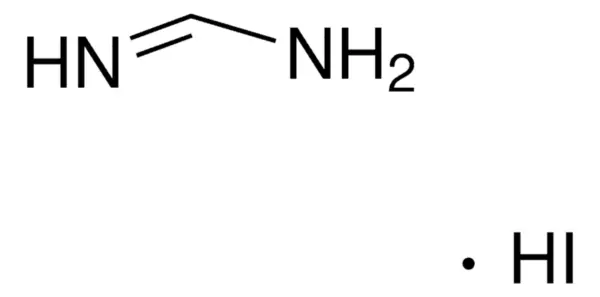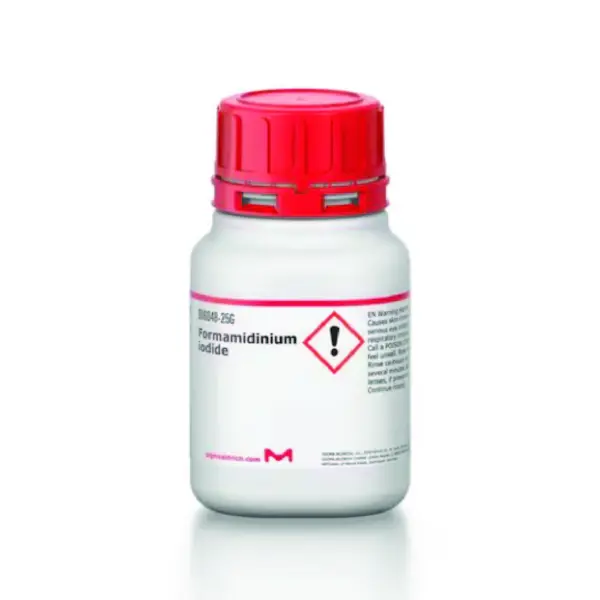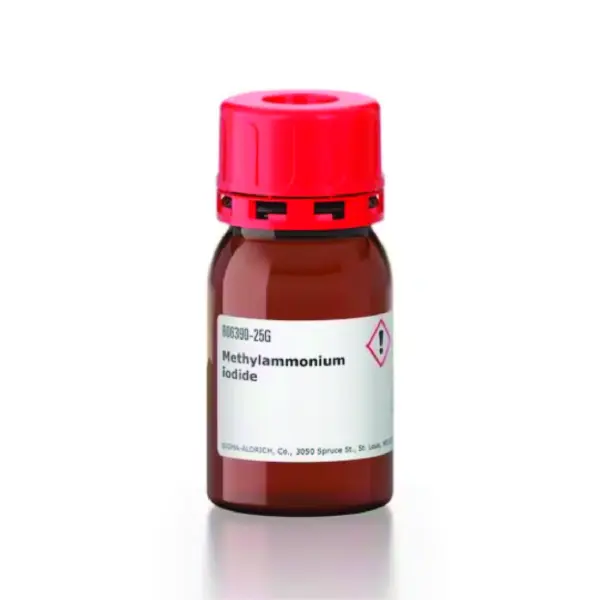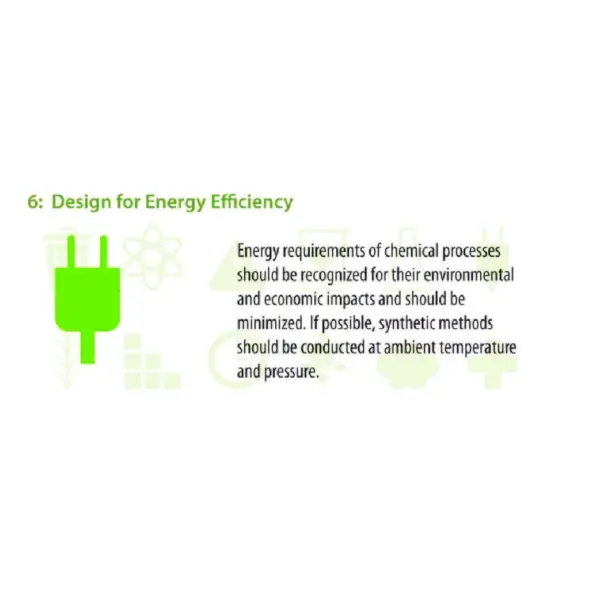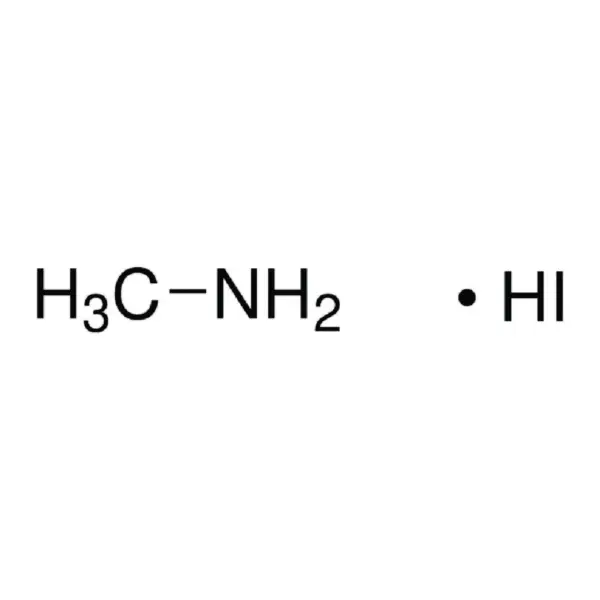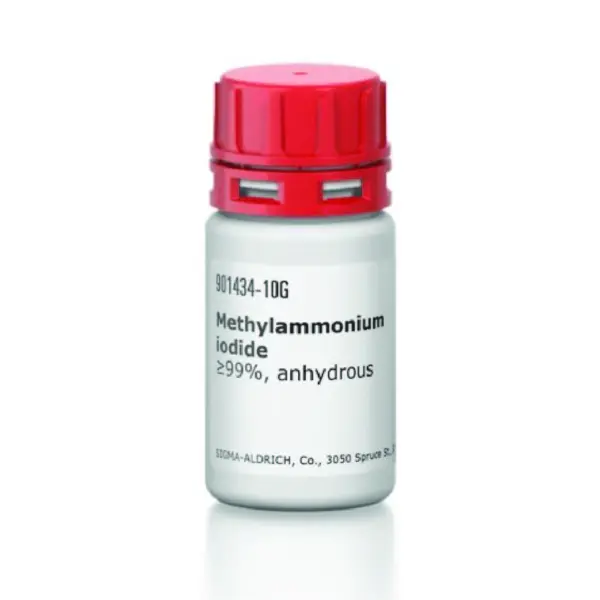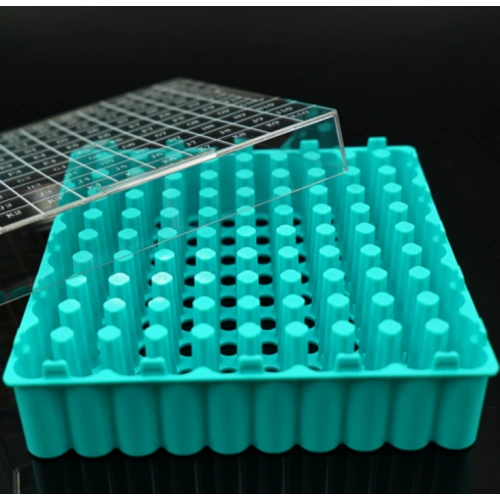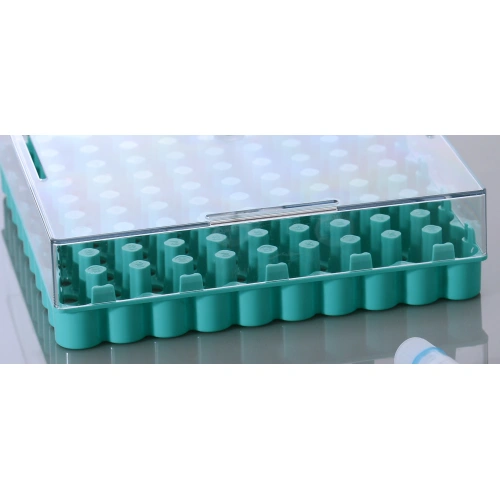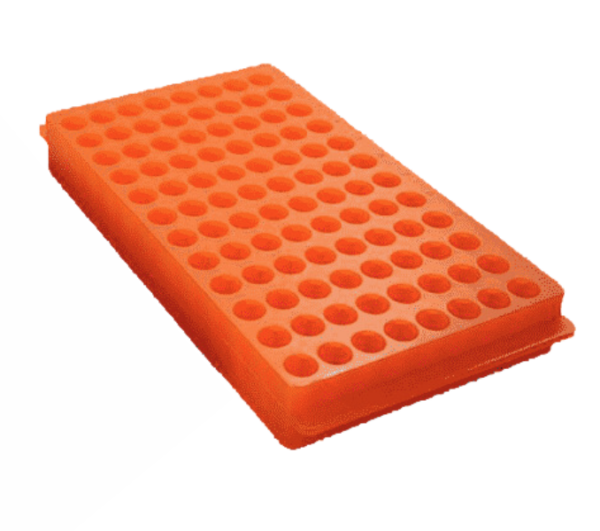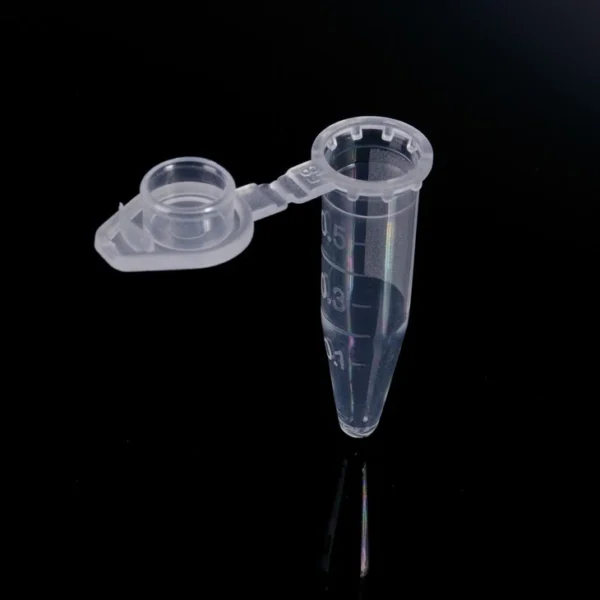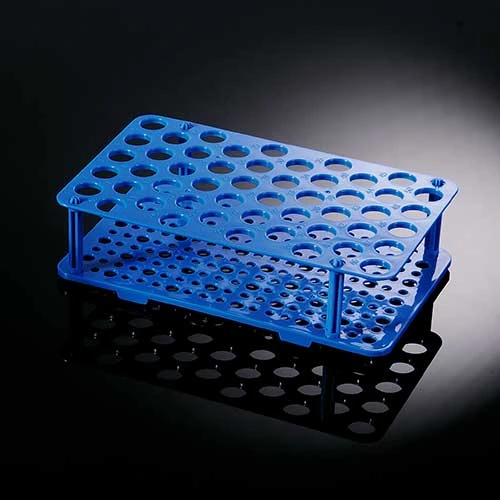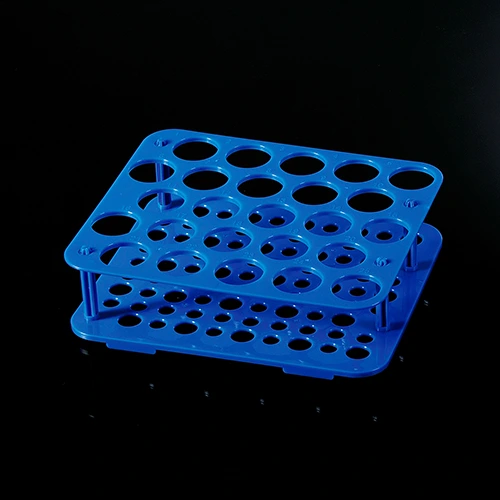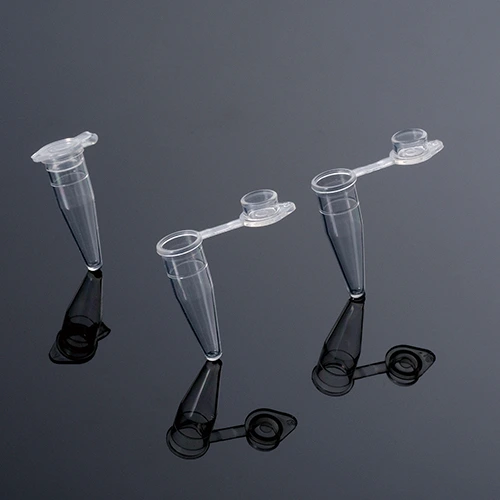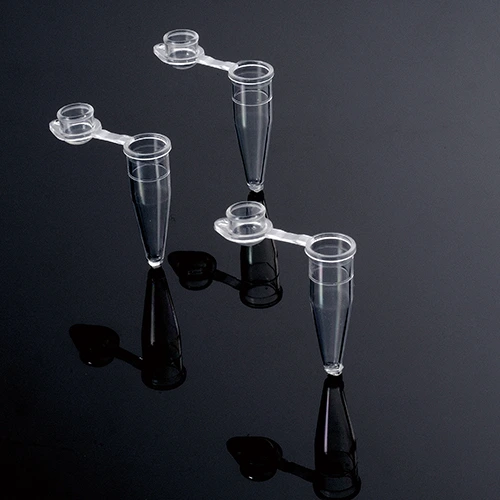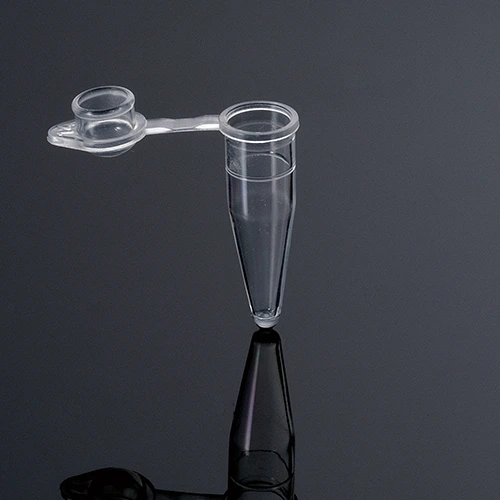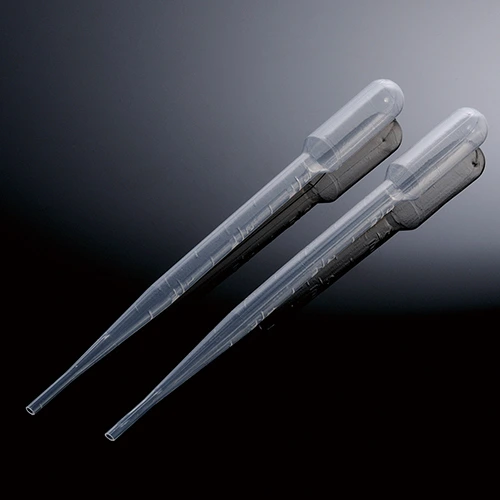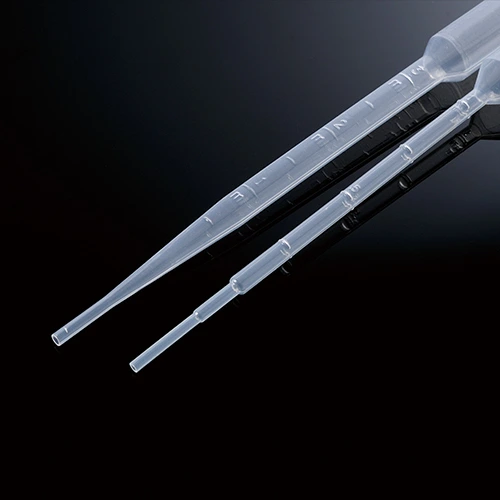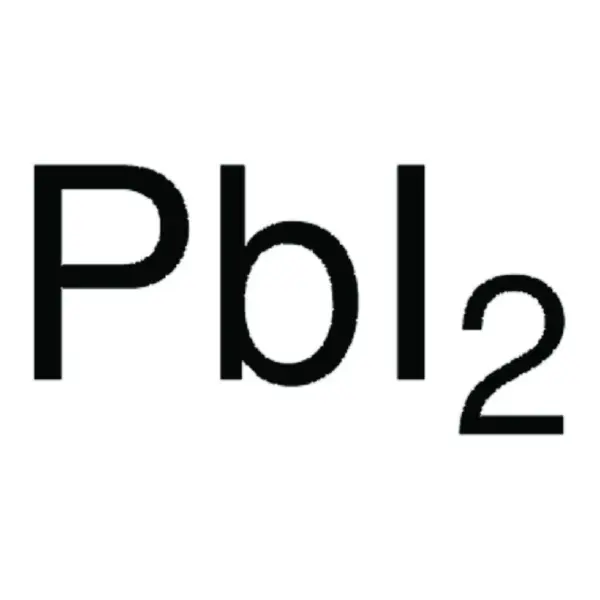
Lead(II) iodide, AnhydroBeads™, −10 mesh, 99.999% trace metals basis – Sigma Aldrich
Login to see pricesBrand:
Sigma-Aldrich
Synonyms
Lead diiodide, Lead diiodide (PbI2), Lead iodide, Plumbous iodide
General Description
Lead(II) iodide is a wide band gap(2.32 eV)semiconductor material with unique properties such as high resistivity, a widetemperature range (−200 °C up to +130 °C), and good chemical stability.
Application
Lead(II)iodide can be used as a starting material to prepare:
- Polycrystalline α-FAPbI3 thin films by solution processing method. These polycrystalline thin films are applicable as photodetectors.
- Organic/inorganic hybrid 2D perovskite materials, applicable in solar cells.
It can also be used to fabricate a gamma-ray detector at room temperature.
Legal Information
AnhydroBeads is a trademark of Sigma-Aldrich Co. LLC
| CAS Number |
10101-63-0 |
| Linear Formula |
PbI2 |
| Molecular Weight |
461.01 |
| Reaction Suitability |
Core: lead |
| Impurities |
≤15.0 ppm Trace Metal Analysis |
| Particle size |
−10 mesh |
| Application(s) |
electroplating |
Formamidinium Iodide, ≥99%, Anhydrous – Sigma Aldrich
Login to see pricesBrand:
Sigma-Aldrich
Synonyms
Formamidine Hydroiodide, methanimidamide hydroiodide
General Description
We are committed to bringing you Greener Alternative Products, which adhere to one or more of The 12 Principles of Greener Chemistry. This product has been enhanced for energy efficiency. Click here for more details.
Application
Formamidinium iodide (FAI) is a compound that finds significant application in the field of photovoltaics, particularly in the development of perovskite solar cells. Formamidinium-based perovskite materials derived from FAI have also shown potential in other optoelectronic applications. These include light-emitting diodes (LEDs), photodetectors and lasers.
Organohalide based perovskites have emerged as an important class of material for solar cell applications[1][2][3][4]. Our perovskites precursors with extremely low water contents are useful for synthesizing mixed cation or anion perovskites needed for the optimization of the band gap, carrier diffusion length and power conversion efficiency of perovskites based solar cells.
| CAS Number |
879643-71-7 |
| Empirical Formula (Hill Notation) |
CH5IN2 |
| Molecular Weight |
171.97 |
| MDL number |
MFCD28369273 |
| UNSPSC Code |
12352111 |
| NACRES |
Na.23 |
| Greener alternative product characteristics |
Design for Energy Efficiency |
Formamidinium Iodide | Greatcell Solar® – Sigma Aldrich
Login to see pricesBrand:
Sigma-Aldrich
Synonyms
Greatcell Solar®, Iminomethylamine hydriodide, Methanimidamide iodide
General Description
We are committed to bringing you Greener Alternative Products, which adhere to one or more of The 12 Principles of Greener Chemistry. This product has been enhanced for energy efficiency. Click here for more details.
Application
Formamidinium iodide (FAI) is an organic halide, which can be used as a precursor solution in the fabrication of perovskite-based heterojunction solar cells.
Formamidinium iodide (FAI) serves as a critical precursor material in the fabrication of perovskite solar cells. FAI is used in material engineering studies to investigate the impact of formamidinium incorporation on perovskite film properties and device performance.
The iodide and bromide based alkylated halides find applications as precursors for fabrication of perovskites for photovoltaic applications.
Legal Information
Product of Greatcell Solar Materials Pty Ltd.
Greatcell Solar® is a registered trademark of Greatcell Solar Materials Pty Ltd
Greatcell Solar is a registered trademark of Greatcell Solar
| Description |
Elemental Analysis: C ~7.0% |
| Linear Formula |
CH5IN2 |
| Molecular Weight |
171.97 |
| MDL number |
MFCD28369273 |
| UNSPSC Code |
12352101 |
| NACRES |
Na.23 |
| Greener alternative product characteristics |
Design for Energy Efficiency |
Methylammonium iodide | Greatcell Solar® – Sigma Aldrich
Login to see pricesBrand:
Sigma-Aldrich
Synonyms
Methanamine hydriodide, Greatcell Solar®, Methanaminium iodide, Methylamine hydriodide, Methylamine hydroiodide, Monomethylammonium iodide
General Description
We are committed to bringing you Greener Alternative Products, which adhere to one or more of The 12 Principles of Greener Chemistry. This product has been enhanced for energy efficiency. Click here for more details.
Application
Methylammonium iodide (MAI) can be used as a precursor in combination with lead iodide to change the morphology of the perovskite materials. Perovskite materials can further be utilized in the fabrication of alternative energy devices such as light emitting diodes (LEDs), and perovskite solar cells (PSCs).
Methylammonium iodide (MAI) is utilized in the production of various optoelectronic devices, including light-emitting diodes (LEDs), photodetectors and lasers. MAI is employed in the synthesis of perovskite-based semiconductors, which have garnered interest in the field of electronics due to their exceptional photovoltaic and optoelectronic properties. MAI can be used to sensitize other types of solar cells, such as dye-sensitized solar cells (DSSCs), by enhancing light absorption and electron transfer processes.
The iodide and bromide based alkylated halides find applications as precursors for fabrication of perovskites for photovoltaic applications.
Legal Information
Product of Greatcell Solar®
Greatcell Solar is a registered trademark of Greatcell Solar
| Linear Formula |
CH3NH2 • HI |
| CAS Number |
14965-49-2 |
| Molecular Weight |
158.97 |
| MDL number |
MFCD28100833 |
| UNSPSC Code |
12352302 |
| NACRES |
Na.23 |
| Greener alternative product characteristics |
Design for Energy Efficiency |
Methylammonium iodide, 98% – Sigma Aldrich
Login to see pricesBrand:
Sigma-Aldrich
Synonyms
Methanamine hydriodide
Application
Methanamine hydriodide is an important precursor for the preparation of perovskite photoactive layers for solar energy conversion. Methylammonium iodide (MAI) is extensively used as a precursor material for the fabrication of perovskite solar cells. These solar cells offer high conversion efficiencies.
Methylammonium iodide can be used as a precursor in combination with lead iodide to change the morphology of the resulting perovskite materials. Perovskite materials can further be utilized in the fabrication of alternative energy devices such as light emitting diodes (LEDs), and perovskite solar cells (PSCs).
Other Notes
We are committed to bringing you Greener Alternative Products, which adhere to one or more of The 12 Principles of Greener Chemistry. This product has been enhanced for energy efficiency. Find details here.
| CAS Number |
14965-49-2 |
| Molecular Weight |
158.97 |
| MDL number |
MFCD28100833 |
| UNSPSC Code |
12352302 |
| NACRES |
Na.23 |
| Greener alternative product characteristics |
Design for Energy Efficiency |
Methylammonium Iodide, ≥99%, anhydrous – Sigma-Aldrich
Login to see pricesBrand:
Sigma-Aldrich
Synonyms
Methanamine, hydriodide
General Description
We are committed to bringing you Greener Alternative Products, which adhere to one or more of the 12 Principles of Greener Chemistry. This product has been enhanced for energy efficiency. Click here for more details.
Application
Methylammonium iodide (MAI) has been widely used in the development of perovskite solar cells. MAI is typically used as a precursor material in the fabrication of perovskite thin films. It acts as a source of methylammonium cations (CH3NH3+) and iodide anions (I-) that are necessary for the formation of the perovskite crystal structure.
Methylammonium iodide, an organic halide-based perovskite material, can be used in the fabrication of high-performance organic solar cells.
Organohalide-based perovskites have emerged as an important class of material for solar cell applications. Our perovskite precursors with extremely low water contents are useful for synthesising mixed cation or anion perovskites needed for the optimization of the band gap, carrier diffusion length and power conversion efficiency of perovskite-based solar cells.
| Lineaer Formula |
CH3NH2 • HI |
| CAS Number |
14965-49-2 |
| Molecular Weight |
158.97 |
| MDL number |
MFCD28100833 |
| UNSPSC Code |
12352302 |
| NACRES |
Na.23 |
| Greener alternative product characteristics |
Design for Energy Efficiency |
Cryogenic Box
Login to see pricesBrand:
NEST
Characteristics
● Temperature range: -196℃ to +70℃
● Individual package
● Clear polycarbonate cover for easy identification
● Alphanumeric grid for easy sample identification
● Each box includes drain holes and air vents to minimise condensation
Microcentrifuge Tube Rack, 96-wells
Login to see pricesBrand:
Bio-Seen
Characteristics
● Made of high strength plastic, chemically resistant to alcohols and mild organic solvents
● Handles on each end for secure handling
● 6×16 array, 96 wells
0.5ml Microcentrifuge Tubes
Login to see pricesBrand:
Biologix
Characteristics
● Made of high quality medical grade polypropylene
● Transparent tube walls permit easy viewing of contents
● Beveled lip for convenient one-handed operation
● Writing area and attached flat cap for labeling
● RNase & DNase free
Specifications
● Working temperature: stable from -20°C to 121°C
● Can withstand high speed centrifugation of 20,000 RCF
Centrifuge Tube Rack
Login to see pricesBrand:
Biologix
Characteristics
● Made of high quality medical grade polypropylene
● 50-well racks hold 15ml centrifuge tubes
● Sturdy design keeps tubes upright
0.2ml PCR Tubes (Flat-top Capes)
Login to see pricesBrand:
Biologix
Characteristics
● Made of prime virgin polypropylene
● Ultra thin-wall offers high degree of transparency, easy for observation and heat conduction
● Domed caps ensure efficient heat transfer, while flat caps are ideal for Real-Time PCR(qPCR), Unique design prevents opening during cycling and incubation
● DNase, RNase, and endotoxin free
● Temperature range: stable from -20ºC to 100ºC
● Universal fits for the PCR instrument; Withstand centrifugation of 6,000 RCF in a fully supported rotor
* Assorted colors for PCR tubes should be ordered separately
0.2ml PCR Tubes (Dome-shaped Caps)
Login to see prices
Brand:
Biologix
Characteristics
● Made of prime virgin polypropylene
● Ultra thin-wall offers high degree of transparency, easy for observation and heat conduction
● Domed caps ensure efficient heat transfer, while flat caps are ideal for Real-Time PCR(qPCR), Unique design prevents opening during cycling and incubation
● DNase, RNase, and endotoxin free
● Temperature range: stable from -20ºC to 100ºC
● Universal fits for the PCR instrument; Withstand centrifugation of 6,000 RCF in a fully supported rotor
* Assorted colors for PCR tubes should be ordered separately
1ml Transfer Pipets
Login to see pricesBrand:
Biologix
Characteristics
● Polyethylene pipettes will not shatter or break
● An excellent alternative to Pasteur pipettes and rubber bulbs
● Evenly distributed thickness ensures uniform suction force
● Gamma radiation sterilised option available

MEL10 MECILLINAM
Login to see pricesBrand:
Thermo ScientificTM OxoidTM
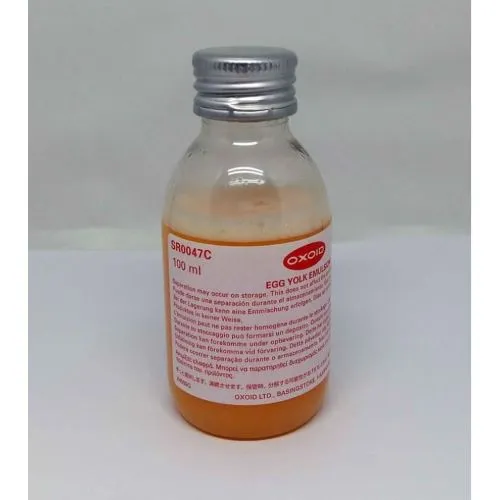
Thermo ScientificTM OxoidTM Egg Yolk Emulsion
Login to see pricesBrand:
Thermo ScientificTM OxoidTM
A stabilised emulsion of egg yolk for use in culture media. It may be added directly to nutrient media for the identification of Clostridium, Bacillus and Staphylococcus species by their lipase activity.
Egg Yolk Emulsion, Oxoid Directions:
Suspend 21.5g of MYP Agar (CM0929) in 450ml of distilled water and bring gently to the boil to
dissolve. Sterilize by autoclaving at 121°C for 15 minutes. Cool to approximately 50°C and
aseptically add 50ml of Egg Yolk Emulsion (SR0047C) and the contents of one vial of Polymyxin B
Supplement (SR0099E) reconstituted as directed. Mix well and pour into sterile Petri dishes.
Alternatively, suspend 8g of Blood Agar Base (CM0055) in 200ml of distilled water and add 2g of
sodium chloride. Sterilize by autoclaving at 121°C for 15 minutes. Cool to approximately 50°C and
aseptically add 20ml Egg Yolk Emulsion (SR0047C). Mix well and pour into sterile Petri dishes.
Storage conditions and Shelf life
Keep at temperatures between 2° and 8 °C. Use before expiry date on the label.
Precautions
On this medium Bacillus cereus is indistinguishable from Bacillus thuringiensis.
Identify Bacillus cereus by colony form, colour, egg yolk hydrolysis and confirm with cell and spore morphology.
Occasional strains of Bacillus cereus show weak or negative egg yolk reactions.
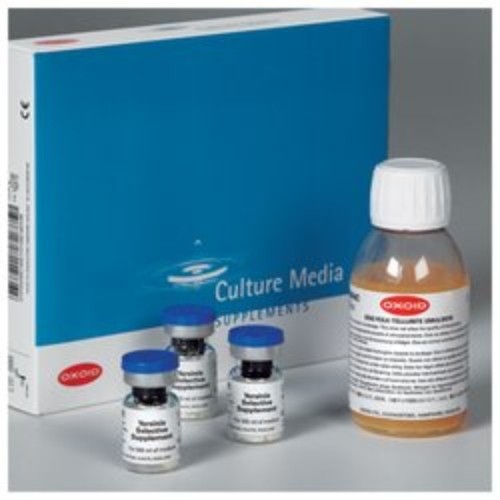
Thermo ScientificTM OxoidTM BrillianceTM Listeria Agar (ISO) Differential Supplement
Login to see pricesBrand:
Thermo ScientificTM OxoidTM
A differential supplement for the detection, enumeration, and presumptive identification of Listeria monocytogenes and other Listeria species from food, animal feed and environmental samples according to ISO 11290-1:2017 and ISO 11290-2:2017 standards and other national reference methods using the Ottaviani & Agosti formulation.
Brilliance Listeria Agar (ISO) Differential Supplement, Oxoid Composition
| Typical Formula |
SR0258E |
per litre
|
| L-α-phosphatidylinositol solution |
15.0ml |
30.0ml
|
Brilliance Listeria Agar (ISO) Differential Supplement, Oxoid Directions:
Aseptically add 5ml of sterile distilled water to 1 vial and mix gently to dissolve. Aseptically add the vial contents to 480ml of sterile Brilliance™ Listeria Agar base (ISO) (CM1212) prepared as directed, cooled to 48°C and add 1 vial of Brilliance™ Listeria Differential Supplement (SR0258E) warmed to 48°C. Mix well and pour into sterile Petri dishes.
Storage conditions and Shelf life
Store the differential supplements (SR0258) at 2-8°C away from light. Do not freeze the differential supplement solution. Ensure all product is used before the expiry date.

Thermo ScientificTM OxoidTM Brilliance Listeria Agar (ISO) Selective Supplement
Login to see pricesBrand:
Thermo ScientificTM OxoidTM
A selective supplement for the detection, enumeration and presumptive identification of Listeria
monocytogenes and other Listeria species from food, animal feed and environmental samples
according to ISO 11290-1:2017 and ISO 11290-2:2017 standards and other national reference
methods using the Ottaviani & Agosti formulation.
Brilliance Listeria Agar (ISO) Selective Supplement, Oxoid Composition
| Typical Formula |
SR0257E |
per litre
|
| Nalidixic acid sodium salt |
10.0 mg |
20.0 mg
|
| Polymyxin B sulphate |
38350 IU |
76700 IU
|
| Ceftazidime |
10.0mg |
20.0mg |
| Amphotericin |
5.0mg |
10.0mg |
Brilliance Listeria Agar (ISO) Selective Supplement, Oxoid Directions:
Aseptically add 1 vial warmed to 48°C to 480ml of sterile Brilliance™ Listeria Agar base (ISO) (CM1212) prepared as directed, cooled to 48°C and add 1 vial of Brilliance™ Listeria Selective Supplement (SR0257E) reconstituted as directed. Mix well and pour into sterile Petri dishes.
Storage conditions and Shelf life
Store the selective (SR0257) supplements at 2-8°C away from light. Ensure all product is used before the expiry date.
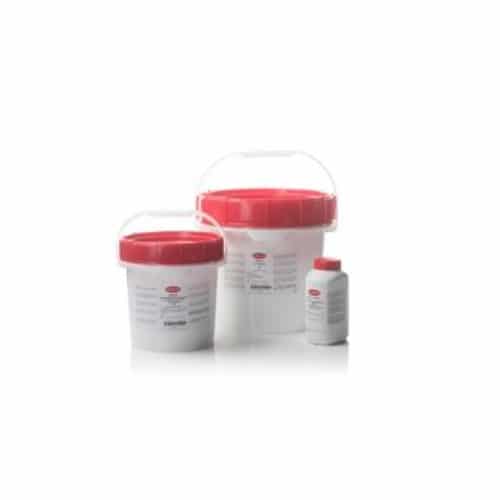
Thermo ScientificTM OxoidTM BrillianceTM Listeria Agar (ISO) Base
Login to see pricesBrand:
Thermo ScientificTM OxoidTM
Isolate, enumerate and presumptively identify Listeria species and L. monocytogenes from food and environmental samples with the Thermo Scientific™ Oxoid™ Brilliance™ Listeria Agar (ISO) (Dehydrated culture medium and supplements) following broth enrichment. The medium identifies Listeria species based on their utilization of X-glucoside giving rise to blue-green colonies. Listeria monocytogenes are further differentiated by their ability to highly produce lecithinase, producing an opaque, white halo around the colony.
Brilliance Listeria Agar (ISO), Oxoid Composition
| Typical Formula * |
gm/litre
|
| Enzymatic digest of animal tissues |
18.0 |
| Enzymatic digest of casein |
6.0 |
| Yeast extract |
10.0 |
| Sodium pyruvate |
2.0 |
| Glucose |
2.0 |
| Magnesium glycerophosphate |
1.0 |
| Magnesium sulphate (anhydrous) |
0.5 |
| Sodium chloride |
5.0 |
| Lithium chloride |
10.0 |
| Di-sodium hydrogen phosphate (anhydrous) |
2.5 |
| 5-Bromo-4-chloro-3-indolyl-β-D-glucopyranoside |
0.05 |
| Agar |
12.0 |
| pH 7.4 ± 0.2 @ 25°C |
Brilliance Listeria Agar (ISO), Oxoid Preparation:
Suspend 34.5g in 480ml of distilled water. Mix well and sterilize by autoclaving at 121°C for 15 minutes. Cool to 48°C. Aseptically add the contents of 1 vial of Brilliance™ Listeria Selective Supplement (ISO) (SR0257E) reconstituted as directed, and 1 vial of Brilliance™ Listeria Differential Supplement (ISO) (SR0258E) warmed to 48°C. Mix well and pour into sterile Petri dishes.
Storage conditions and Shelf life
Store the dehydrated medium (CM1212B) at 10-30°C away from light and ensure bottles are correctly sealed after use.
Store prepared medium for up to 2 weeks at 2-8°C, away from light. Ensure all media is used before the expiry date on the label

Buffer tablets pH 7.2, Merck
Login to see pricesBrand:
Merck
Buffer tablets pH 7.2 – for preparing buffer solution acc. to WEISE for staining of blood smears, are used to prepare buffer solutions according to WEISE and pH-buffered staining solutions. Phosphate buffer solutions are used in hematology, for the dilution of staining solutions and for the rinsing steps in the staining process. The buffer tablets acc. to Weise will produce a buffered solution (pH6.4/pH6.8/pH7.2) that stabilizes the staining result and gives reproducible staining results. Buffer solution acc. to Weise pH 6.4 results in bright-orange stained erythrocytes and differentiated stained cells with nuclei, whereby the erythrocytes are stained orange when using pH 6.8. Buffer solution acc. to Weise pH 7.2 produces grayish stained erythrocytes and intense red-violet stained cells with nuclei.
100 tablets are sufficient for 100 l buffer solution, each produced solution can be stable up to 4 weeks. Buffer tablets acc. to Weise are IVD products and CE registered.
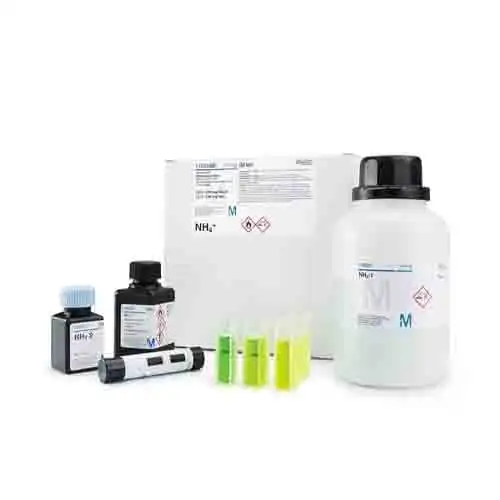
Cyanide Test, Merck
Login to see pricesBrand:
Merck
The method corresponds to DIN 38405-13 and is analogous to ISO 6703, EPA 335.2, APHA 4500-CN- E, and ASTM D2036-09 D.
This Spectroquant® Cyanide Reagent Test allows the accurate quantification of the free and readily liberated cyanide content in aqueous samples.
Method applied: Cyanide ions react with a chlorinating agent to form cyanogen chloride. In a follow-up reaction with 1,3-dimethylbarbituric acid in the presence of pyridine a violet dye (König reaction) is formed which is determined photometrically (only free cyanide. For readily liberated cyanide samples must be decomposed by digestion).
The Spectroquant® Reagent Test Kits contain highly stable, ready-to-use reagent mixtures to perform the analysis according to the procedure described in the accompanying instruction leaflet.
All our Cell and Reagent Test Kits are equipped with the unique Live ID which allows seamless method recognition and contains essential information such as lot number, expiry date, and automatic calibration updates.
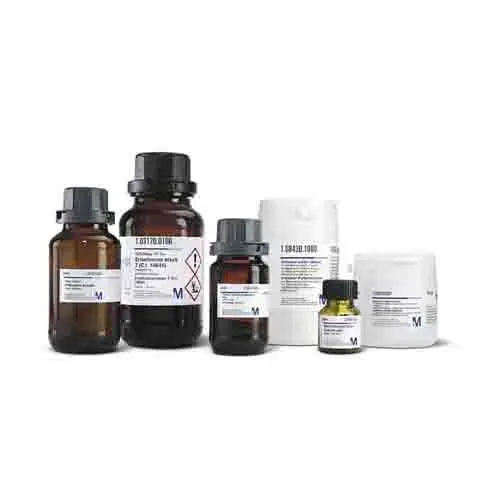
Kjeldahl Tablets for Wieninger Method, Merck
Login to see pricesBrand:
Merck
Kjeldahl tablets for Wieninger method 5g/tablet.
Type: Wieninger catalyst Composition:
Na2SO4 – 96.5%
CuSO4 – 1.5%
Se – 2.0%
Kjeldahl tablets is grey colour in its appearance. Grey colour of the product is caused by raw material and does not affect the application.
TLC Silica gel 60 F₂₅₄, (20×20 cm) – Merck
Login to see pricesBrand:
Merck
Description
For thin-layer chromatography applications, we offer Aluminum TLC plates that are coated with silica gel containing a fluorescent indicator F254. These silica gel TLC plates are available in a set of 25 and measure 20x20cm. Our classical silica TLC plates are created by combining our established silica gel 60 with a unique polymeric binder. This combination produces a very adherent and robust surface that will not crack or blister and can even withstand writing with a pencil without risking damage to the layer.
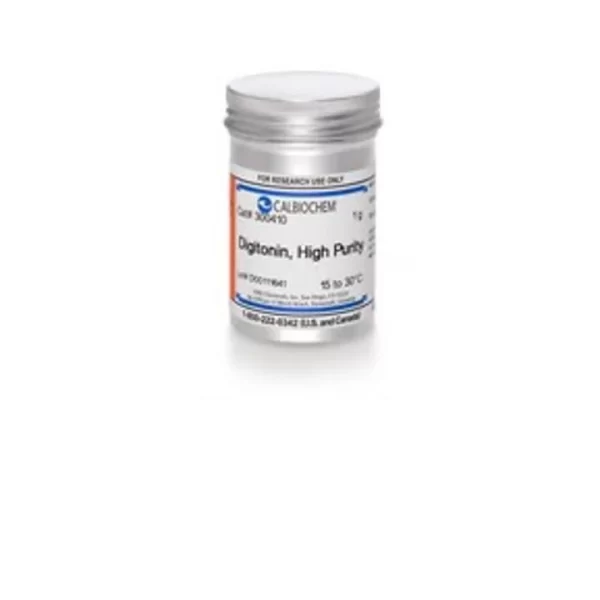
Digitonin, High Purity – CAS 11024-24-1 – Calbiochem (Merck)
Login to see pricesBrand:
Merck
**This product is not currently sold in Malaysia, please contact us for more information
Description:
CAS Number : 11024-24-1
Empirical formula : C56H92O29
A non-ionic detergent commonly used to solubilize membrane-bound proteins.
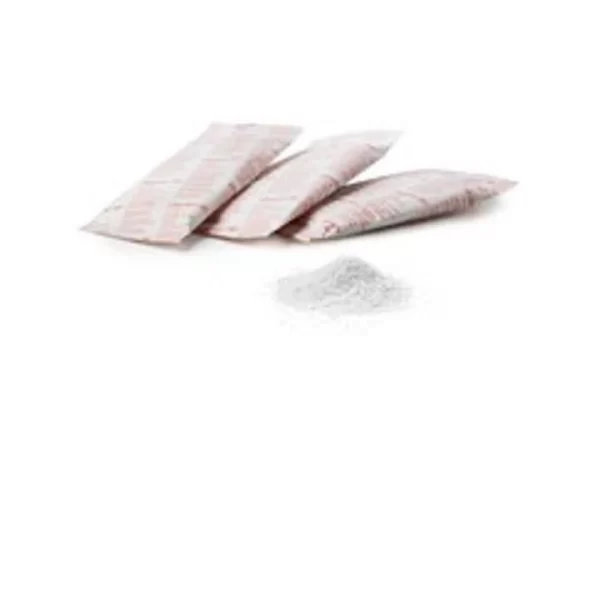
EXtrelut® NT Refill pack for column fillings EXtrelut® NT 20 (Merck)
Login to see pricesBrand:
Merck
Description:
CAS Number : 68855-54-9
Extrelut® NT simplifies liquid-liquid extraction in its most effective form by using a chemically inert, wide-pore and highly pure diatomaceous earth based solid phase. Depending on the sample volume three types of columns are available: Extrelut® NT1 can take up a maximum of one ml, Extrelut® NT3 three ml and Extrelut® NT20 up to twenty ml of sample.


